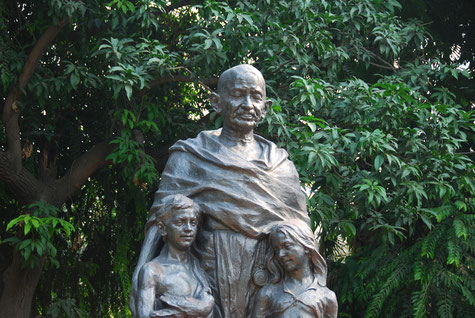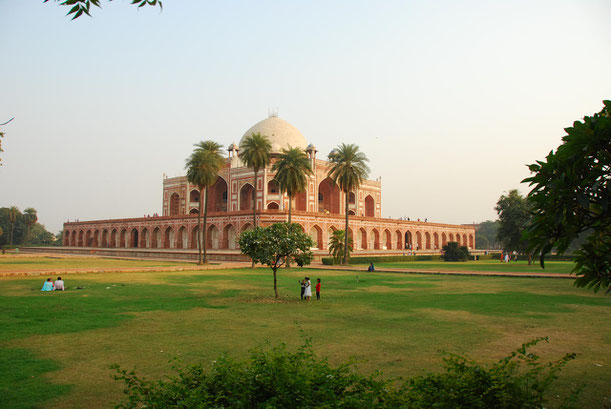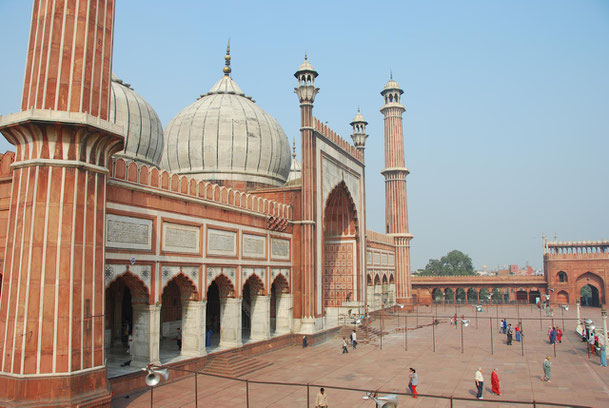India 2014 - Delhi
Gandhi Smriti

Situated in the heart of Delhi Gandhi Smriti is a museum dedicated to the father of the indian nation - Mahatma Gandhi. Formerly this estate was known as Birla House, property and home of the indian business tycons - the Birla Family. Mahatma Gandhi spent his last 144 days as a guest in Birla House.
On 30 January 1948 he was assassinated at this place.
In 1971 the state of India bought the estate und turned it into a museum. The house and its gardens still appear as they were in 1948.
Humayun's Tomb

Humayun, born in Kabul 1508, was the second Mughal Emperor. 1531-1540 and 1555-1556 he ruled over an area that is roughly todays Afghanistan, Pakistan and parts of Northern India, including Delhi.
After his death 1556 his then 13 years old son Akbar became his successor and third Mughal Emperor. 1565 Akbar commissioned the tomb and Humayuns persian wife Bega Begum assigned a persian architect with the task. Thus the tomb exhibits strong persian influence and stands as an example for the merging of indian and persian style.
In 1993 UNESCO declared the tomb World Heritage Site.
Red Fort

The Red Fort was constructed by Shah Jahan1638-1648.
At that time the name of the city was Shahjahanabad and the capital of the Mughal Empire was Agra. Only Aurangzeb, the son of Shah Jahan, ruled from Delhi.
Shah Jahan also built the Taj Mahal in Agra. Both, the Red Fort and Taj Mahal, are situated at the banks of the Yamuna River.
In 1857 after the First War of Independence the British cleared the then much dilapidated fort and used it as a military camp.
On India's independence Day, August 15th, the Prime Minister of India holds a speech to the nation from the ramparts of Lahore Gate.
The Red Forts has an area of about 100ha. The Imperial Apartments receive most attention from the visitors. They are lined up as rather small pavillions - but in their time most exquisiteley furnished and decorated by gold, silver and precious stones - connected by a water channel, surrounded by a formerly persian style garden.
In 2007 the Red Fort was declared World Heritage Site by UNESCO.
Gurdwara Sis Ganj Sahib
Gurdwara Sis Ganj Sahib is a Sikh temple in Old Delhi just next to Lahore Gate of the Red Fort.
The ninth of ten Sikh Gurus, Guru Tegh Bahadur, is said to have been decapitated at this place on the order of Mughal Emperor Aurangzeb in 1675.
Jama Masjid

Jama Masjid is india's largest mosque with enough space for 25.000 people. It is situated in Old Delhi not far away from the Red Fort.
It was built by Shah Jahan between 1644 and 1658.
Safdarjang's Tomb

The name Safdarjang is the honorific title for Mirza Muqim Abul Mansur Khan (1708–1754), who emigrated from Persia to Delhi in 1722.
The tomb is known to be one of the last monumental tomb gardens of the Mughal era. It is situated in Delhi not far away from Humayun's Tomb and the Lodi Gardens.
Safdarjang was ruler of Avadh, a rather small state of Northern India. 1748 he was made the Chief Minister of the Mughal empire. But exceeding his power he was driven out of his position and out of Delhi 1753, and died in 1754.
His son was allowed to build this tomb for his father.
The core structure of the tomb is of local bricks. The outside is made of local sandstone and marble from Rajasthan.
India Gate, Rajpath & Raisina Hill

British architect Lutyens who is responsible for the city plan of New Delhi, chose a slightly elevated area, today called Raisina Hill, as the place for the residence of the Prime Minister of Inida, the Prime Minister's office, Parliament of India and other official buildings.
East of the hill lies India Gate. It is a memorial to more than 80.000 soldiers who died in the First World War and the Third Anglo-Afghan War. Just under the arch is India's Tomb of the Unknown Soldier.
Raisina Hill and India Gate are connected by a ceremonial boulevard named Rajpath (Kings Way).
Jantar Mantar
Mughal emperor Muhammad Shah gave the task for astronomical observations to Maharaja Jai Singh II of Jaipur. The Maharaja therefore built altogether five observation sites, all called Jantar Mantar. The largest one can be found in Jaipur.
Construction of the site in Delhi probably started in the year of 1724.






































































































